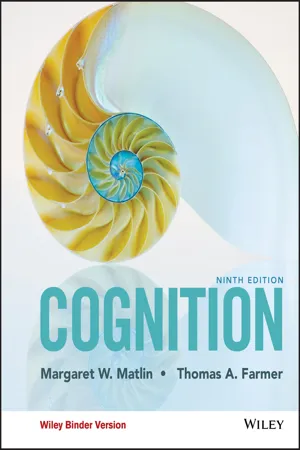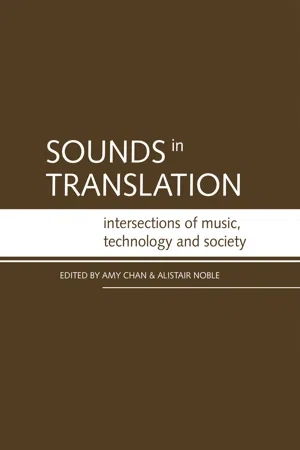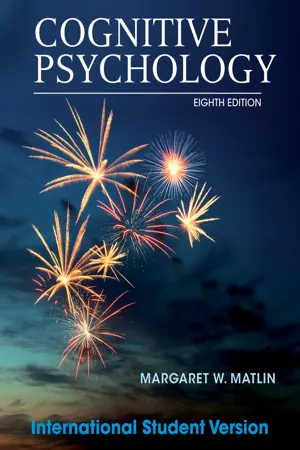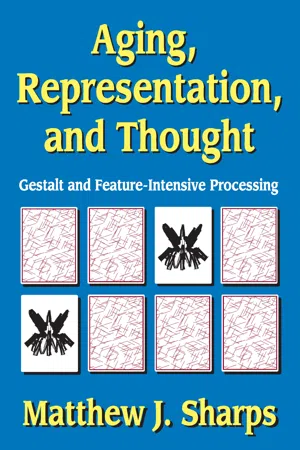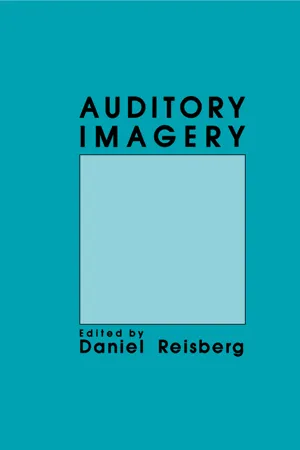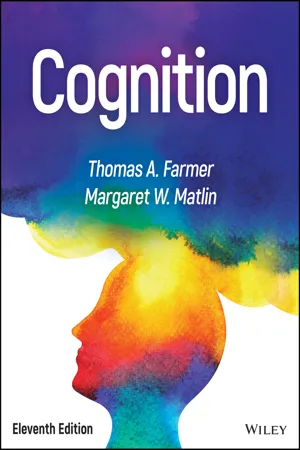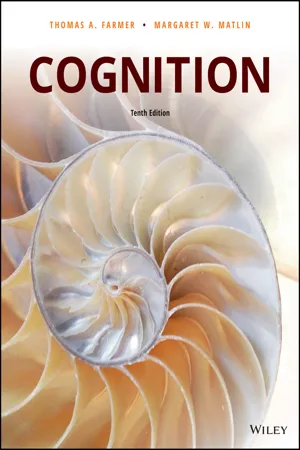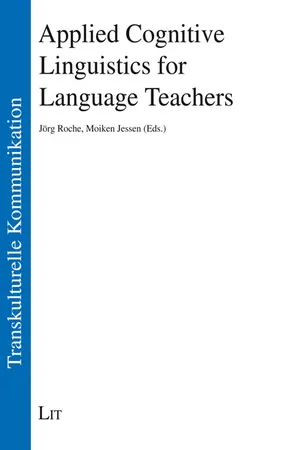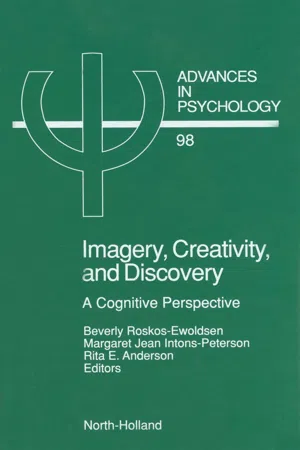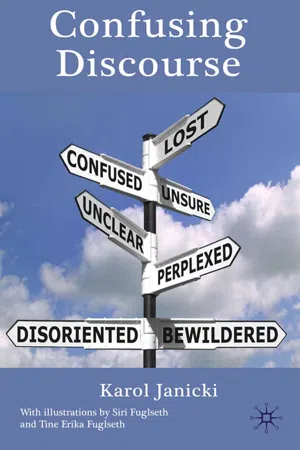Languages & Linguistics
Auditory Imagery
Auditory imagery refers to the mental representation of sounds, often used in literature to evoke sensory experiences for the reader. It involves creating vivid auditory sensations through descriptive language, allowing the reader to "hear" the sounds being described. This technique can enhance the reader's immersion in the text and contribute to a more engaging and memorable reading experience.
Written by Perlego with AI-assistance
Related key terms
1 of 5
10 Key excerpts on "Auditory Imagery"
- eBook - PDF
- Margaret W. Matlin, Thomas A. Farmer(Authors)
- 2016(Publication Date)
- Wiley(Publisher)
d) Trying to think about the sound of a particular word in French, while mentally rotating a mental image of a friend’s face. 5) Various experiments on visual imagery, such as one in which participants compared shapes of states of the United States, led one researcher (Paivio, 1978) to conclude that imagery coding is: a) symbolic. b) propositional. c) structural. d) analog. Auditory Imagery Most research on the topic of mental imagery has tended to focus heavily on visual imagery, and it turns out that people tend to report more visual imagery than other types of mental imagery. Kosslyn and his colleagues (1990), for example, asked stu- dents to keep diaries about their mental imagery. They reported that about two-thirds CHAPTER 7 Mental Imagery and Cognitive Maps 250 of their images were visual. In contrast, images for hearing, touch, taste, and smell were much less common. Psychologists show a similar lopsidedness in their research preferences. Most of the research focuses on visual imagery, though the research on Auditory Imagery has increased during the last decade. In contrast, psychologists rarely investigate smell, taste, or touch imagery. As we noted at the beginning of this chapter, Auditory Imagery is our mental rep- resentation of sounds when these sounds are not physically present. For example, can you create a vivid auditory image of a close friend’s laughter? Can you create a vivid auditory image for the irst few bars of a favorite song? What other categories of audi- tory images can you create in your “mind’s ear”? We can typically identify a variety of “environmental sounds,” even though we might not use that particular term. For example, can you create an auditory image of the whining sound made by an almost-dead car battery? In addition, we typically have Auditory Imagery for the distinctive noises made by a variety of animals (Wu et al., 2006). This section on Auditory Imagery provides an introduction to the topic. - eBook - PDF
Sounds in Translation
Intersections of music, technology and society
- Amy Chan, Alistair Noble, Amy Chan, Alistair Noble(Authors)
- 2009(Publication Date)
- ANU Press(Publisher)
3. Translating the musical image: case studies of expert musicians Freya Bailes There is more to music than the production and perception of real sounds; musical experience also involves musical thought through imagining and mentally re-presenting sounds. This can occur unintentionally, as in the phenomenon often called ‘tune on the brain’. Alternatively, imaging music can be an involuntary corollary of musical activity, such as anticipating the next track on an album while listening to music or working towards an ideal musical sound in performance based on internally ‘hearing’ how it should sound. Finally, a mental image of music can be deliberate, as in the ‘silent’ analysis of a musical score or the auralisation of sound in harmony and counterpoint exercises. How does musical thought in the form of musical imagery—a mental image of how the music should sound—translate to musical production? Musical imagery is the conscious experience of an internal representation of music, or inner hearing . Various definitions of imagery have been offered. In the auditory domain, Intons-Peterson (1992:46) describes it as ‘the introspective persistence of an auditory experience, including one constructed from components drawn from long-term memory, in the absence of direct sensory instigation of that experience’. Musical imagery is a production of the mind’s ear . It can differ importantly as an experience from the internal processes that channel and interpret any real incoming sensory information, otherwise known as perception . Imagination encompasses imagery, being ‘the faculty or action of producing mental images of what is not present or in one’s own experience’ ( Collins New English Dictionary 1997). The other definition of imagination (from the same source) as ‘creative mental ability’ presents imagery as a key ingredient in creative thought. - eBook - PDF
- Margaret W. Matlin(Author)
- 2014(Publication Date)
- Wiley(Publisher)
The second section of this chapter focuses on the characteristics of Auditory Imagery, a topic that has generated much less research than visual imagery. Still, the research shows that people’s imagery about pitch is similar to their actual perception of pitch. Researchers have also explored timbre, which is the quality that makes a flute’s sound different from a trumpet’s sound. As it happens, people’s imagery about timbre is also similar to their perception of timbre. Our third major topic is cognitive maps. A cognitive map is a mental representation of geographic information, including your visual imagery of the environment that surrounds you. For instance, you have developed a cognitive map for the town or city in which your college is located. Our cognitive maps show certain systematic distortions. For example, you may think that two streets intersect at right angles, even when the angles are far from 90 degrees. Because of these distortions, our mental maps are a more organized and more standardized version of reality. CHAPTER INTRODUCTION Take a moment to close your eyes and create a clear mental image of the cover of this textbook. Be sure to include details such as its size, shape, and color, as well as the photo of the nautilus shell. Now try to create an auditory image. Can you hear the voice of a close friend saying your name? Finally, close your eyes again and create a ‘‘mental map’’ of the most direct route between your current location and the nearest store where you can buy a quart of milk. All three of these tasks require mental imagery (also called imagery), which is the mental representation of stimuli when those stimuli are not physically present (Kosslyn et al., 2010). You can have a mental image for any sensory experience. However, most of the psychology research examines visual imagery, or the mental representation of visual stimuli. - eBook - ePub
Aging, Representation, and Thought
Gestalt and Feature-Intensive Processing
- Matthew Sharps(Author)
- 2017(Publication Date)
- Routledge(Publisher)
per se has been very little addressed on either the memory or higher processing dimension. The auditory-imagery aspects of speech and language have been addressed very comprehensively, as has the role of Auditory Imagery in virtually every kind of music (e.g., Bigand, 1993; Halpern, 1992; Hubbard & Stoeckig, 1992). However, Auditory Imagery as such has been largely neglected in the literature (Baddeley & Logie, 1992), and generally continues to be relatively ignored (e.g., Sharps & Pollitt, 1998). Cogent analyses of the auditory processing of words, phrases, sentences, musical notes, timbre, and pitch are all readily available; an understanding of the auditory images created by things themselves (e.g., the sound of a drill, the roar of a lion, the squeak of chalk on a chalkboard) is not.Specialized anatomical structures for the processing of auditory images are of course known to exist, primarily in the temporal lobe in humans (e.g., Shepherd, 1994), just as specialized structures for the processing of visual information (primarily occipital) and verbal material (primarily frontal and temporal) also exist. This anatomical specialization might superficially lead to the conclusion that these types of information are in fact processed in isolation from one another. However, the existence of specialized anatomical structures for the perception and preliminary interpretation of these different types of information does not really imply functional processing isolation. In fact, given the need for the processing of fundamentally different types of energies derived from the visual and auditory realms; given the necessary conversion of light and mechanical energy, in vision and audition respectively, from the external environment into the electrochemical energy compatible with the brain; and given the specialized systems needed to convert both the spoken and written word into organized energetic systems which the brain can both process and organize, it would be remarkable if identifiable anatomical mechanisms for providing these relevant energetic pathways did not exist. The fact that different kinds of information in the external work make use of, and derive from, different types of physical energies would of course imply the existence of different kinds of neurological “tools” to cope with them, in a manner roughly analogous to the fact that electrical wiring in a house does not make use of pipes and valves, and that the plumbing system does not involve switches, wires and bulbs. The important question here is not one of initial intake and handling of stimulus energies, which of course require different types of systems for transformation and organization into the coding systems actually used by the brain. Rather, the question of concern here transcends the initial energetic vector of information. The central issue is one of how information, probably represented in a relatively interchangeable form at the ultimate level, is processed, modified and manifested at the experiential, or proximate, level. The suggestion here, again, is that ultimately at the neurological level, verbal, auditory, and visual information possess some degree of interchangeability. However, the representational manifestation of these types of information at the experiential level should depend in part, probably in large part, on task demand characteristics. - eBook - ePub
- Daniel Reisberg(Author)
- 2014(Publication Date)
- Psychology Press(Publisher)
The evidence seems to proclaim that auditory images contain information about pitch. They also may contain information about loudness, timbre, and other ancillary features (e.g., kinesthesis) more often associated with familiar auditory objects than with unfamiliar ones. Loudness and other ancillary features affect Auditory Imagery when required by the task. The interference studies suggest that auditory images may invoke some of the same processes as perception. There also is evidence for a general interference effect from the imposition of a dual task. Further bolstering the parallelism between Auditory Imagery and perception is the occasional report of facilitation when the messages conveyed by the image and the percept coincide. Imagery reflects cognitive influences, as well, for Segal and Fusella (1970) found that the detection of signals was differentially sensitive to images of familiar versus unfamiliar objects. Similar results have been reported for visual images.No model of Auditory Imagery exists. Instead, researchers have borrowed heavily from the visual imagery literature. Most of these models focus on the dependence of images on perception and are, therefore, not well equipped to handle evidence of the role of cognition on images. Two fairly recent models are designed to include imagery, perception, and cognition. Both of them are based on work with visual imagery, but can be applied to Auditory Imagery with ease.Perhaps the biggest challenge is generating and testing models of both visual and Auditory Imagery. Such models presumably could be extended to other forms of imagery. We need principled research designed to ascertain the role of same- and cross modal effects in the two kinds of imagery, to examine specific predictions from models, and to identify the conditions under which auditory—and other—imageries are or are not dependent upon perception and cognition.ACKNOWLEDGMENTS I want to thank Robert Crowder, Andrea Halpern, Daniel Reisberg, Wendi Russell, and Robert J. Weber for reading and commenting on the chapter. REFERENCESAdams, K. L., & Ware, N. C. (1989). Sexism and the English language: The linguistic implications of being a woman. In J. Freeman (Ed.), Women (pp. 470–484). Mountain View, CA: Mayfield.Anderson, J. R. (1978). Arguments concerning representation for mental imagery. Psychological Review, 85, 249–277.Attneave, F., & Olson, R. K. (1971). Pitch as a medium: A new approach to psychophysical scaling. American Journal of Psychology, 84, 147–166.Baird, J. C., Wagner, M., & Noma, E. (1982). Impossible cognitive spaces. Geographic Analysis, 14 - eBook - PDF
- Thomas A. Farmer, Margaret W. Matlin(Authors)
- 2023(Publication Date)
- Wiley(Publisher)
In other words, mental imagery is knowledge-driven—it involves utilizing the infor- mation stored in long-term memory to create internal images of sounds and objects that you have previ- ously experienced. This chapter explores three important aspects of imagery. First, we examine the nature of visual images, followed by a discussion of factors that influence mental imagery. We then consider the nature of auditory images, before addressing cognitive maps as our final topic. Cognitive maps are mental representations of geographic information. Classical Research on Visual Imagery 127 Classical Research on Visual Imagery Mental imagery (also called imagery) refers to the mental representation of stimuli when those stimuli are not physically present in the environment (Kosslyn et al., 2010). You can have a mental image for any sensory experience. Most of the psychological research on mental images, however, has focused on visual imagery, or the mental representation of visual stimuli. Fortunately, during the past decade, the research has increased for Auditory Imagery, which is the mental representation of auditory stimuli. In this section, we first examine some key topics and questions related to research on mental imagery before discussing mental rotation, a form of visual imagery. We then consider a controversial debate in the field of mental imagery—namely, a debate about the format of the stored knowledge that we access when creating mental images. Overview of Mental Imagery We use mental imagery for a wide variety of everyday cognitive activities (Denis et al., 2004; Tversky, 2005a). For example, consider a situation in which you can’t find your car keys, although you know that they must be somewhere on your messy desk. You must create and maintain a mental image of your keys while you visually inspect your messy desk to find your keys. - eBook - PDF
- Thomas A. Farmer, Margaret W. Matlin(Authors)
- 2019(Publication Date)
- Wiley(Publisher)
Thus, the processes that give rise to your ability to create mental images are exclusively top-down in nature (Kosslyn & Thompson, 2000). In other words, mental imagery is knowledge-driven—it involves utilizing the information stored in long-term memory to create internal images of sounds and objects that you have previously experienced. Mental Imagery and Cognitive Maps Classical Research on Visual Imagery 135 This chapter explores three important aspects of imagery that have intrigued contemporary researchers. First, we examine the nature of visual images, with an emphasis on the way that we can transform these images. We then consider the nature of auditory images, a relatively new topic in cognitive psychology. Our third topic focuses on cognitive maps, which are mental representations of geographic information, including the environment that surrounds us. Classical Research on Visual Imagery Mental imagery (also called imagery) refers to the mental representation of stimuli when those stimuli are not physically present in the environment (Kosslyn et al., 2010). You can have a mental image for any sensory experience. Most of the psychological research on mental images, however, has focused on visual imagery, or the mental representation of visual stimuli. Fortunately, during the past decade, the research has increased for Auditory Imagery, which is the mental representation of auditory stimuli. In this section, we first examine some key topics and questions related to research on mental imagery before discussing mental rotation, a form of visual imagery. We then consider a controversial debate in the field of mental imagery—namely, a debate about the format of the stored knowledge that we access when creating mental images. Overview of Mental Imagery We use mental imagery for a wide variety of everyday cognitive activities (Denis et al., 2004; Tversky, 2005a). - Jorg Roche, Moiken Jessen(Authors)
- 2023(Publication Date)
- LIT Verlag(Publisher)
95 3 Linguistic Imagery It is astounding to see how important the role of images is in our mind. Not only in terms of modern media (visual turn) but also in the realm of lan- guage. As imagery in language is so prevalent in everyday lives the present chapter will concentrate solely on language imagery and its special role in cognition and language acquisition. To illustrate the prevalence of images in language, let us look at a couple of expressions such as to solve a prob- lem or to break someone’s heart. If we took the expressions at face value, we would have to expect a chemical experiment on an issue (in the sense of the dissolution of something in an acidic solution) or a physical assault on someone’s heart. In the first part of the chapter, we will explore how such metaphors and metonymies work and how traditional linguistics describes and explains these phenomena. Subsequently, we will discuss cognitive mechanisms fundamental to the ubiquitous imagery use in language We will also elab- orate on metonymy, a linguistic element quite similar to metaphor. The conceptual metaphor theory will be presented and compared with the tra- ditional (literary) perspective on metaphors. We will touch on the concep- tual metaphor’s ability to represent mappings between cultural domains, and we will address the role of imagery for the way we think. It will be shown how abstract concepts can be understood through images. Finally, we will explore the role of imagery with respect to the processes of knowledge construction, knowledge representation and knowledge storage in a learner’s mind. 96 3.1 Linguistic Imagery and the Conceptual Metaphor Natalya Furashova, Moiken Jessen & Katsiaryna EL-Bouz Sometimes, people are not straightforward with what they mean to say, and – on the other hand – words are not always used to express their literal meaning. We could, for instance, say about a person that he is cun- ning or clever.- eBook - PDF
Imagery, Creativity, and Discovery
A Cognitive Perspective
- B. Roskos-Ewoldsen, M.J. Intons-Peterson, R.E. Anderson(Authors)
- 1993(Publication Date)
- North Holland(Publisher)
At the same time, though, this boundary on learning is readily escaped. Given explicit instructions or other appropriate cues, subjects can change an image’s reference frame, and this changes what can be discovered within the image. Likewise, subjects have the option of externalizing the image, either by drawing a picture (for visual imagery) or speaking aloud (for Auditory Imagery). The resulting stimulus then exists quite independently of any reference frame, and so can readily be understood within a new reference frame. So far, this summary has emphasized the same points for visual and Auditory Imagery. But the evidence also indicates a point of divergence between the modalities. In Auditory Imagery, subjects have the option of creating a covert stimulus, via subvocalization. Thus subjects can make discoveries from (subvocalized) auditory images even though they fail to make the corresponding discoveries from visual images. As a concrete case, consider the various studies of imaged ambiguous figures. The Chambers 8z Reisberg (1985) subjects failed to reinterpret a visual image of an ambiguous figure, and, correspondingly, the Reisberg et al. (1989) subjects failed to reinterpret a pure image of an auditory ambiguous figure. In both cases, subjects easily reinterpreted the figure once a stimulus was provided (a drawing in the former study and overt speech in the latter). The point of contrast, though, arises when subvocalization was allowed. With access to this covert stimulus, the Reisberg et al. 58 Daniel Reisberg & Robert Logie subjects were able to reinterpret the auditory image. Thus subvocalization plainly broadens the range of what can be accomplished with Auditory Imagery. In fact, Auditory Imagery seems often to rely on subvocalization, and, in particular, to rely on a partnership between inner speech and hearing. Subjects do not need to be coached or instructed in how to use this partnership; it seems instead to be a natural and spontaneous strategy. - eBook - PDF
- K. Janicki(Author)
- 2009(Publication Date)
- Palgrave Macmillan(Publisher)
Try to draw ‘substance’, ‘truth’, ‘reality’, ‘society’, ‘permutation’, ‘transformation’, and so on! Visualizations may take place only in your mind. We often say things like: ‘imagine two people standing in the street and talking to each other’. What we do then is pull out from our memory a rough picture of the kind of situation requested. We are often asked to pull out this kind of mental picture in order to understand better whatever the other person intends to communicate to us. Mental images, imagination, imagery, image schemas, mental pic- tures, and related concepts play a central role in cognitive linguistics (see for instance, Lakoff 1987; Johnson, M. 1987, 1993; Gibbs 1994, 2006; Palmer 1996; Lakoff and Johnson 1999; Evans and Green 2006). According to most cognitive linguists, many aspects of mental imagi- nation play an important role in our handling of concepts, the little bits and pieces in terms of which we process and understand the world around us; concepts may very well be viewed as mental descriptions, or pictures. Importantly , as mentioned in Chapter 1, cognitive linguists often stress that the basic-level concepts (for instance, ‘dog’, ‘table’, ‘car’) Can You Imagine It? 195 invoke a single mental image (see for instance Rosch 1978; Lakoff 1982). These are also the concepts that children learn first and understand best (see, for instance, Lakoff and Johnson 1999). These basic-level concepts are contrasted with superordinate level concepts (for instance, ‘animal’, ‘furniture’) where no such single image emerges (see, for instance, Lakoff 1982, 1987). It should be no surprise to us then that visualization plays an important role in facilitating understanding. As mentioned above, visualization connects with concreteness.
Index pages curate the most relevant extracts from our library of academic textbooks. They’ve been created using an in-house natural language model (NLM), each adding context and meaning to key research topics.
